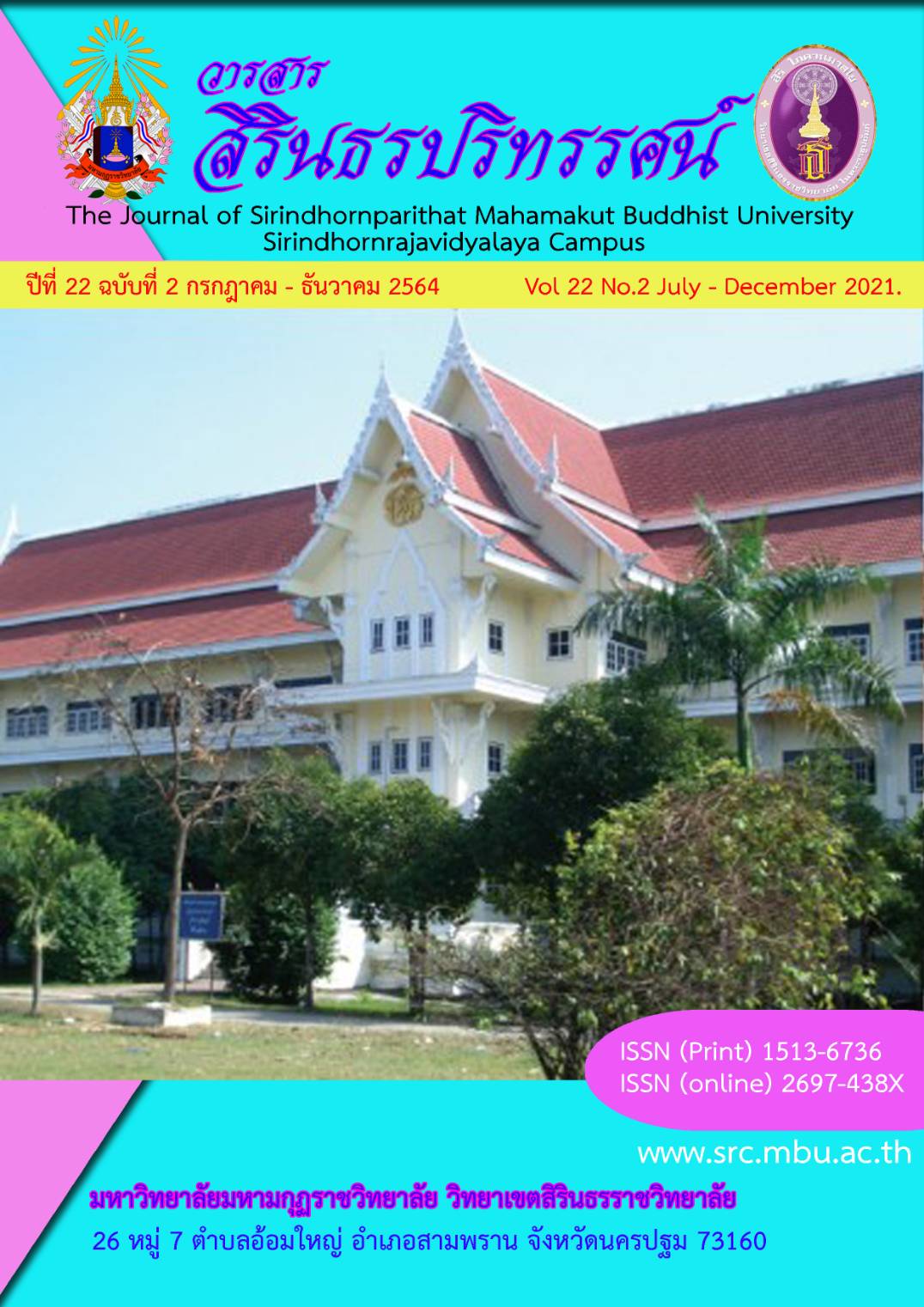The role of moral teaching in Samut Sakhon schools
Keywords:
Role, Buddhist moral teaching at schoolAbstract
This research has 3 objectives; 1) to study the role of school moral teaching monk in Samutsakhon Province’s school; 2) to compare the role of them within the difference of their age, year of being monk, and educations ; 3) to getting recommendations and problems about the their role and teaching methods. Populations and samplings of this research are 96 persons by choosing the Kregcie’s tables and use simple random sampling method. Research tool is the questionnaire and compute by statistic method as frequency, percentile, means, standard deviation and One-way ANOVA.
Research found that as follow;
1.The school moral teaching monks in Samutsakon province have acted role in 3 modes are the most level at 4.08 and while arranging high – low point of data it found that the personal mode of monk was high level at 4.22 and low level was the teaching media mode.
2. The result of hypothesis testing found that the school moral teaching monk which were difference age, year of being monk, and their education are not difference by static method.
3. The recommendations are follow 1) personal mode; some monks are very excited while they were teaching at school and have some their adaptation’s problem with context of class and school so they should practice teaching and being self-confidence on the other hands some monks getting so close with some students and this mislead their students are lack of paying their respects for this case it should put the position of moral teaching monk at the appropriate ways. 2) Teaching method mode; some moral teaching monk used teaching by reading book for student that lead their student getting bored so they should teach their students by difference teaching such as telling the tale and etc. to eager student’s interesting. 3) Teaching media mode; the moral teaching monk need to inform their teaching time table when they want to use computer room for teaching. There should be a variety of teaching methods or the production of teaching materials with drawings.
References
กรมการศาสนา. (2551). คู่มือการดำเนินงานตามโครงการครูพระสอนศีลธรรมในโรงเรียน.กรุงเทพมหานคร : โรงพิมพ์คุรุสภา.
จามจุรี จำเมือง, สถิตชัย วรานนท์วนิช และอุษณีย์ จำเมือง.(2557) คู่มือเตรียมสอบผู้บริหารสถานศึกษา และผู้บริหารการศึกษา. กรุงเทพมหานคร : ไฮเอ็ดพับลิชชิ่ง,
ฉันทนิช อัศวนนท์. (2530). การพัฒนาบุคลิกภาพ. กรุงเทพมหานคร : สถาบันเทคโนโลยีราชมงคล วิทยาเขตจักรพงษภูวนารถ.
บุญหนา จิมานัง และคณะ. (2551). “การประเมินประสิทธิภาพการสอนของพระสอนศีลธรรมในสถานศึกษาเขตปกครองคณะสงฆ์ภาค 9”. รายงานการวิจัย. สำนักวิชาการ : มหาวิทยาลัยมหาจุฬาลงกรณราชวิทยาลัย วิทยาเขตขอนแก่น.
พระกุ๊ ญาณวีโร. (แซ่ฮ้อ, 2551). “ความคิดเห็นของนักเรียนชั้นประถมศึกษาปีที่ 6 ที่มีต่อการสอนวิชาพระพุทธศาสนาของพระธรรมวิทยากรศึกษาเฉพาะกรณีโรงเรียนในเขตอำเภอกระทุ่มเบน จังหวัดสมุทรสาคร ปีการศึกษา 2550”. วิทยานิพนธ์การศึกษามหาบัณฑิต. บัณฑิตวิทยาลัย : มหาวิทยาลัยมหามกุฏราชวิทยาลัย.
พระครูสุนทรธรรมโสภณ (วิเชียร ปญฺญาวุฑฺโฒ). (2545). หลักการสอน. นครปฐม : มหาวิทยาลัยมหา มกุฏราชวิทยาลัย วิทยาเขตสิรินธรราชวิทยาลัย ในพระราชูปถัมภ์.
พระธรรมปิฎก (ป.อ. ปยุตฺโต). (2544). พุทธวิธีในการสอน. กรุงเทพมหานคร : โรงพิมพ์บริษัท สหธรรมิก จำกัด.
พระราชรัตนมงคล. (มนตรี ยางธิสาร, 2547). “ความคิดเห็นของครูพระสอนศีลธรรมเกี่ยวกับการปฏิบัติงานสอนในโรงเรียนเขตกรุงเทพมหานคร”. วิทยานิพนธ์การศึกษามหาบัณฑิต. บัณฑิตวิทยาลัย : มหาวิทยาลัยศรีนครินทรวิโรฒ.
ระวีวรรณ วุฒิประสิทธิ์ และคณะ. (2530). หลักการสอน. กรุงเทพมหานคร : ศูนย์การศึกษาสำหรับครูทางวิทยุไปรษณีย์ กรมการฝึกหัดครู.
ศูนย์บริการวิชาการ. สถิติข้อมูลพระสอนศีลธรรมในโรงเรียน วิทยาเขตสิรินธรราชวิทยาลัย ปีการศึกษา 2561, (อัดสำเนา)
ส่งศรี ชมภูวงศ์. (2553). ระเบียบวิธีวิจัยทางสังคมศาสตร์. นครศรีธรรมราช. มหาวิทยาลัยราชภัฏนครศรีธรรมราช.
สถิต วงศ์สวรรค์. (2539). การพัฒนาบุคลิกภาพ. กรุงเทพมหานคร : สำนักพิมพ์อักษรพิทยา.
Downloads
Published
Issue
Section
License
Copyright (c) 2022 Mahamakut Buddhist University

This work is licensed under a Creative Commons Attribution-NonCommercial-NoDerivatives 4.0 International License.
บทความที่ได้รับการตีพิมพ์เป็นลิขสิทธิ์ของ มหาวิทยาลัยมหามกุฏราชวิทยาลัย วิทยาเขตสิรินธรราชวิทยาลัย
ข้อความที่ปรากฏในบทความแต่ละเรื่องในวารสารวิชาการเล่มนี้เป็นความคิดเห็นส่วนตัวของผู้เขียนแต่ละท่านไม่เกี่ยวข้องกับหาวิทยาลัยมหามกุฏราชวิทยาลัย วิทยาเขตสิรินธรราชวิทยาลัย และคณาจารย์ท่านอื่นๆในมหาวิทยาลัยฯ แต่อย่างใด ความรับผิดชอบองค์ประกอบทั้งหมดของบทความแต่ละเรื่องเป็นของผู้เขียนแต่ละท่าน หากมีความผิดพลาดใดๆ ผู้เขียนแต่ละท่านจะรับผิดชอบบทความของตนเองแต่ผู้เดียว




